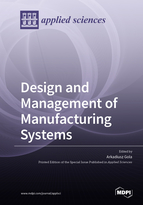Design and Management of Manufacturing Systems
A special issue of Applied Sciences (ISSN 2076-3417). This special issue belongs to the section "Mechanical Engineering".
Deadline for manuscript submissions: closed (15 August 2020) | Viewed by 72593
Special Issue Editor
Interests: manufacturing system design; operations management; production logistics
Special Issues, Collections and Topics in MDPI journals
Special Issue Information
Dear Colleagues,
Because of growing globalization and contemporary market demands, manufacturing efficiency is more and more often defined not only as the capacity for low-cost production of specified quality products, but also as the capacity for quick execution of variable and low-volume orders at reduced manufacturing costs. In this context, new practical and scientific results are of great interest and importance for industrial engineering. Special attention is continuously given to the problems of reducing manufacturing costs by manufacturing systems design and production process planning, organization, and control. Therefore, I would like to invite you to submit your research papers to the Special Issue of the Applied Sciences journal “Design and Management of Manufacturing Systems”.
This Special Issue seeks high-quality works focusing on the following topics:
- focused flexibility manufacturing systems design;
- reconfigurable manufacturing systems design;
- continuous improvements in production units;
- manufacturing systems capacity balancing;
- optimal and sustainable production planning;
- robust cyclic scheduling;
- multicriteria optimization in operations management;
- sustainable material handling systems design;
- AI driven production planning and control.
I look forward to receiving your contributions for this Special Issue.
Dr. Arkadiusz Gola
Guest Editor
Dr. Arkadiusz Gola
Guest Editor
Manuscript Submission Information
Manuscripts should be submitted online at www.mdpi.com by registering and logging in to this website. Once you are registered, click here to go to the submission form. Manuscripts can be submitted until the deadline. All submissions that pass pre-check are peer-reviewed. Accepted papers will be published continuously in the journal (as soon as accepted) and will be listed together on the special issue website. Research articles, review articles as well as short communications are invited. For planned papers, a title and short abstract (about 100 words) can be sent to the Editorial Office for announcement on this website.
Submitted manuscripts should not have been published previously, nor be under consideration for publication elsewhere (except conference proceedings papers). All manuscripts are thoroughly refereed through a single-blind peer-review process. A guide for authors and other relevant information for submission of manuscripts is available on the Instructions for Authors page. Applied Sciences is an international peer-reviewed open access semimonthly journal published by MDPI.
Please visit the Instructions for Authors page before submitting a manuscript. The Article Processing Charge (APC) for publication in this open access journal is 2400 CHF (Swiss Francs). Submitted papers should be well formatted and use good English. Authors may use MDPI's English editing service prior to publication or during author revisions.
Keywords
- Manufacturing systems
- Operations management
- Production planning optimization
- Production logistics
- Decision support






